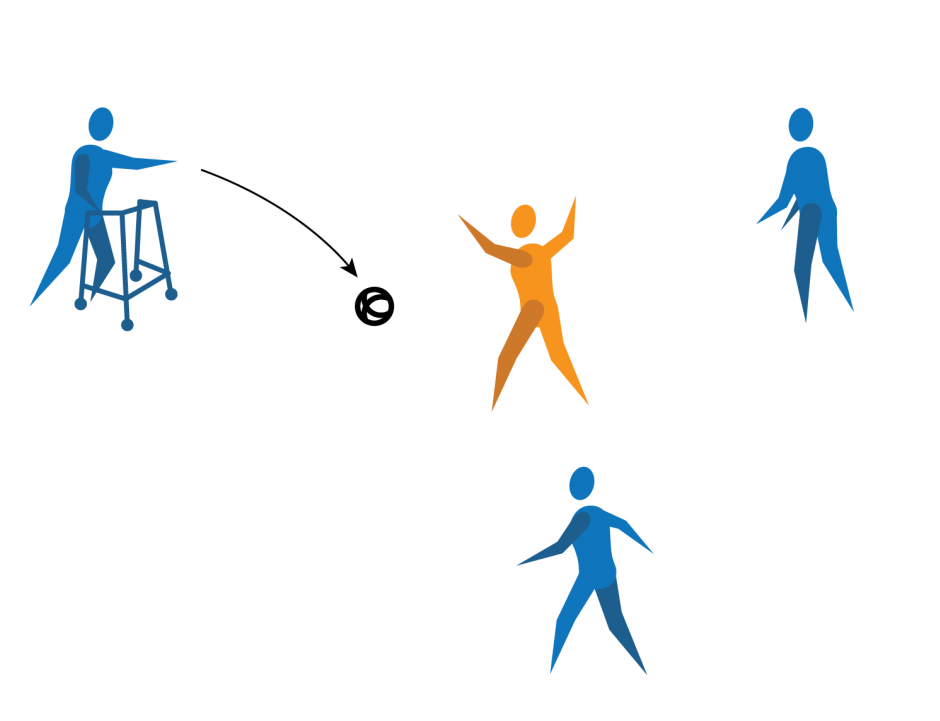TGfU Category: Zone Games
Locations: gymnasium, outdoor space (e.g., field, tarmac)
Game/Sport Connections
Zone games are activities that involve controlling an object, keeping it away from opponents, and moving it into position to score. Both offensive and defensive players share the same playing area as they work to prevent the other team from scoring. By playing these games, participants develop skills and tactics to play other zone games or games that require the application of similar skills, concepts, and strategies (e.g., soccer, handball, ultimate Frisbee, football, basketball, hockey, goalball, wheelchair basketball, lacrosse).
Activity Overview
Participants learn about and practise keeping possession of an object while playing against a defender. Participants learn about and practise applying defensive skills, concepts, and strategies to gain and maintain possession of an object.
Key Movement Skills, Concepts, and Strategies
Throughout the activity, consider highlighting the following skills, concepts, and strategies to help participants maintain possession of an object by keeping it away from a defender. Note that this list is not exhaustive and further learning opportunities may arise during the task.
Movement Skills and Concepts
- Manipulation skills and effort awareness: applying a controlled force to send and receive the object to keep possession of the object (e.g., using short, quick passes to group members to make it challenging for the defender to intercept the object).
- Spatial awareness and relationship: directing how the body moves and extends when sending/receiving the object while playing against the defender (e.g., keeping an eye on where the object is travelling, being in a ready position with knees bent and shoulder width apart, hands up ready to intercept the object).
Movement Strategies
- Applying appropriate skills to be proficient at controlling the object and sending/receiving it to another participant while playing with an opponent (e.g., keeping eyes on the incoming object and moving into its path to successfully receive it).
- Making quick decisions as a group about what to do to increase the chances of success with sending/receiving the object (e.g., communicating with other group members to successfully receive the object).
Considerations
- Incorporate some or all of the variations listed in the “Variations” section while planning the activity. This will help to best meet the diverse backgrounds, identities, needs, and interests of participants and maximize the fun, inclusion, participation, and success of everyone.
- To elevate participant voice and choice, periodically pause the activity and share the variations with participants. Ask them to determine how they would like to change the activity to maximize the fun, inclusion, meaningful participation, and success for everyone. Encourage participants to add any variations of their own.
Equipment
- 1 object to send per group (e.g., beach ball, foam ball, basketball, rubber chicken, deck ring, foam disc, volleyball)
- 4 pylons or cones per group
Safety
- Inspect the equipment and activity area to identify and remove hazards. Check that the activity surface provides sufficient traction.
- Establish the boundaries for the designated playing area at a safe distance from walls and obstacles. Share the boundaries with participants.
- Review the safety rules and activity instructions with participants prior to the activity.
- Instruct participants to be aware of their surroundings, including the locations of other participants during play.
How to Play
- Divide participants into groups of 4.
- Assign each group a designated playing area. Have groups mark the boundaries of their playing area with pylons or cones.
- Ask a participant to be the defender.
- Have the 3 other participants form a triangle around the defender so the defender is in the middle. Participants may increase or decrease the size of their triangle at any point during play, being mindful of other participants’ designated playing areas.
- Have groups select 1 object to send (e.g., beach ball, foam ball, basketball, rubber chicken, deck ring, foam disc, volleyball).
- Participants who form the triangle move around their playing area attempting to send the object to one another without dropping it and without having the defender intercept the pass.
- Defenders are not allowed to grab the object from an opponent’s hand.
- If a pass is intercepted or unsuccessful, the defender switches places with the sender of the pass. Participants in the triangle work to complete 5 successful passes in a row, and then rotate so that another participant becomes the defender.
- After a period of play, provide participants with some or all of the variations. Ask them to decide how they might change the game to enhance their fun, challenge, and success. Encourage participants to add any variations of their own.
- Consider having groups share their variations and select another variation to try with their group.
Image: Visual Depiction of the Activity Instructions

Pause for Learning
Throughout the activity, ask open-ended questions to help participants refine their movement skills, strategies, and tactical solutions. Examples include:
- If you are in possession of the object, how do you decide which group member to send it to?
- When playing as the defender, what strategy do you apply that helps you successfully intercept the object?
- Which games or sports have you played or know about that use similar rules and strategies to the ones used in this game?
Variations
- Participants cannot pass the object back to the person who just passed it to them.
- Only the defender (participant in the middle) can move.
- Limit available time to pass the object. When on offence, if the object is not passed within 3 seconds, the offensive team loses possession.
- Begin with no defender so that participants become accustomed to moving, sending, and receiving the object.
- Increase the number of times participants pass the object before switching places with the defender or receiving a point.
- Send the object an alternate way (e.g., kick along the ground, bounce pass, overhead pass, with an implement for striking).


